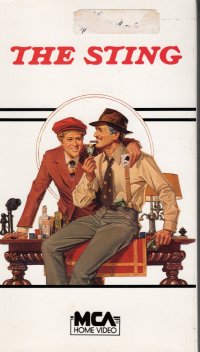 This film came out the year after I was born, but I was aware of it and of the presence of “The Entertainer” by Scott Joplin in it (I eventually learned it) and because I had a Cracked magazine parody of it at one time, which must have somehow meant I obtained an older copy of the magazine or that they were still parodying the film in the early 1980s when I would have been buying Cracked magazine at the little drug store next to the neighborhood grocery store. A neighborhood grocery store? How old am I? In one of my local newspapers, I read about a woman retiring from the local grocer after forty-three years, and she talked about having to memorize sale prices in the paper because they didn’t have scanners. You know, I came to work in a grocery store, a small almost neighborhood grocery store, in 1990, and we were just at the tail end of the scanners–we still had price sticker guns in the produce department for some applications–which means, mein Gott, I am getting old, and I can only tell you of the way things were in the last century. Younger people will hear, but not understand.
This film came out the year after I was born, but I was aware of it and of the presence of “The Entertainer” by Scott Joplin in it (I eventually learned it) and because I had a Cracked magazine parody of it at one time, which must have somehow meant I obtained an older copy of the magazine or that they were still parodying the film in the early 1980s when I would have been buying Cracked magazine at the little drug store next to the neighborhood grocery store. A neighborhood grocery store? How old am I? In one of my local newspapers, I read about a woman retiring from the local grocer after forty-three years, and she talked about having to memorize sale prices in the paper because they didn’t have scanners. You know, I came to work in a grocery store, a small almost neighborhood grocery store, in 1990, and we were just at the tail end of the scanners–we still had price sticker guns in the produce department for some applications–which means, mein Gott, I am getting old, and I can only tell you of the way things were in the last century. Younger people will hear, but not understand.
In the film, a couple of small grifters in Joilet, Illinois, roll a man using a scam to swap his money for a bundle of paper. They think they’ve made the big score, but they only got so much because it was a mob courier they scammed. When the heat comes down and his partner is killed, Johnny Hooker (Robert Redford) goes to Chicago to learn the “big con” from his former partner’s contact Henry Gondorff (Paul Newman), who is hiding from the FBI. They target the mob figure responsible for Hooker’s partner’s death, and the film details how they build a story that Gondorff runs an off-track betting parlor (betting on horse races), and Hooker is his disaffected henchman. Gondorff out-cheats Lonnegan (Robert Shaw) at cards on a train ride and sends Hooker to collect his winnings at Lonnegan’s, and Hooker indicates he’s willing to turn on Gondorff if Lonnegan will give him a good role. So he, Hooker, indicates that he has a connection who can give horse race results before they become available–an elaborate setup of having a fake announcer at the betting parlor holding race results for a couple of minutes so they can tip Lonnegan which way to bet. When they ultimately clean him out, they stage a fake FBI raid on the parlor and Hooker and Gondorff are shot during the raid. After a crooked cop leads Lonnegan off, Hooker and Gondorff walk off into the Casablanca fog extolling the beginning of their beautiful friendship (although I might be confusing that with the ending of another film).
It’s a period piece, a costume drama, and it features title cards and “bumper” music between acts for a little extra throwback flavor. Additionally, it’s clever in the heist’s execution and the dialog rings true. And one gets a bit of a sense who the characters are beyond their spoken lines. My goodness, gentle reader, was this the anachronism of depth in acting? I believe so. Of course, perhaps the modern shallow acting technique merely mirrors the expressive but brief and shallow emotions modern people, bred, educated, and conditioned by small screens, feel (citation needed).
I understand there’s a sequel, but I am not sure I’ve ever seen it in the wild. The copy I have is on VHS, which I presume means it was bought by a consumer before DVDs were popular. Most of the DVDs one finds in the wild come from films from the years after, what, 1986 (along with some earlier blockbusters/classics/Disney reissues)? So a 1983 lesser facsimile of a smash from 1973 might fall into that dead zone of eras. I suppose I could do some research on it and publish a paper, but to what end? I’d never become president of a major university based on my scholarship in twee and unimportant, impractical matters.


